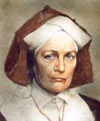
Hildegard was the tenth child of of a noble German family. At the age of 8, she was sent to live with Jutta, the sister of a count whom Hildegard’s father served as a knight. When Hildegard was 14, she, Jutta, and one or two others, were enclosed as anchorites. At some point Jutta’s anchorhold grew into a Benedictine monastery, connected to the adjacent male monastery of St. Disibod. The number of nuns grew to about 10 at Jutta’s death in 1136 and to about 20 twelve years later.
After Jutta’s death, Hildegard was named prioress, leader of the nuns but under the authority of the abbot of St. Disibod. Within a few years, Hildegard told her confessor of visionary experiences; he had her write them down and showed them to the abbot. The abbot and the local archbishop ordered Hildegard to continue writing. After some resistance, Hildegard agreed and began the ten-year task of writing what would become Scivias,a report of 26 visions that would sum up Christian doctrine on the history of salvation.
In 1147, Hildegard was still concerned, not about the truth of her visions, but about whether they should be published, so she wrote to Bernard, abbot of the Cistercian monastery of Clairvaux. He responded favorably and when Hildegard’s archbishop showed part of Scivias to Pope Eugenius, Bernard encouraged his fellow Cistercian to approve it.
While Hildegard was still working on Scivias (and writing hymns—some of her songs were apparently known in Paris by 1148), she decided to leave St. Disibod with her nuns and establish a separate foundation some miles away, near Bingen. The abbot of St. Disibod was not happy about the move, but with the help of the archbishop, the foundation of St. Rupert’s monastery was made by 1151, the year before the completion of Scivias.
The early 1150’s were a time of privation at St. Rupert’s, but gradually Hildegard was able to enlarge and consolidate the new monastery’s holdings. She also wrote a series of non-visionary works: Ordo virtutem (Play of the virtues) a play which grew out of a passage at the end of Scivias; a medical encyclopedia, Liber simplicis medicinae,and notes for a medical handbook, Liber compositae medicinae. This was also apparently the period in which Hildegard first collected her songs as Symphonia armonie celestium revelationum(Symphony of the harmony of heavenly revelation).
Around 1158 Hildegard began to write the second of her visionary works, Liber vitae meritorum (Book of life’s merits), a work of moral instruction. She also began a series of travels that would, over the next 13 years, take her to men’s and women’s monasteries and to urban cathedrals to preach to religious and secular clergy. We know of these trips because of the extensive correspondence Hildegard carried on until her death.
As soon as Hildegard completed Liber vitae meritorum, in about 1163, she began to write her last major work, Liber divinorum operum (Book of the divine work), on the relationship of humans to God and to each other. This work took over ten years to complete and seems to represent her most mature thought (it has not yet been fully translated).
We know little of Hildegard’s last years: She completed her final preaching tour in about 1171, when she was 73 years old. Her long-time secretary died in 1173, but she said in a 1175 letter that she was continuing to write regularly, despite the press of monastery affairs. (St. Rupert’s had grown to include some 50 nuns, plus servants and laborers; a new foundation with about 30 nuns had been had been made in 1165, and Hildegard continued to supervise that as well.)
Source: Other Women’s Voices
Selected Poems / Prayers of Hildegard of Bingen
- Antiphon for the Angels
- Ave Generosa
- Ave Maria
- God’s Word is in all creation
- Loving Tenderness
- O glistening sunlight
- O greening branch
- Song to the creator
Links
- Hildegard of Bingen – Poems and Hymns
- Christian Mystics
Other Women’s Voices – Very useful collection of information and web links about Hildegard of Bingen
